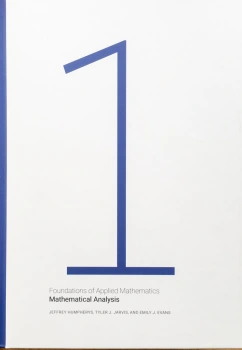
Foundations of Applied Mathematics, Volume 1: Mathematical Analysis was published by SIAM this summer. Written by Jeffrey Humpherys, Tyler J. Jarvis, and Emily J. Evans, all from Brigham Young University, this is the first of a four-book series, aimed at the upper undergraduate or first year graduate level. It lays the analysis and linear algebra foundations that the authors feel are needed for modern applied mathematics.
The next book, Volume 2: Algorithms, Approximation, and Optimization, is scheduled for publication in 2018.
At 689 pages, hardback, beautifully typeset on high quality paper, and with four colours used for the diagrams and boxed text, this is a physically impressive book. Unusually for a SIAM book, it contains a dust jacket. I got a surprise when I took it off: underneath is a front cover very different to the dust jacket, containing a huge number 1. I like it and am leaving my book cover-free.
I always look to see what style decisions authors have made, as I ponder them a lot when writing my own books. One was immediately obvious: the preface uses five Oxford commas in the first six sentences!
I have only had time to dip into a few parts of the book, so this is not a review. But here are some interesting features.
- Chapter 15, Rings and Polynomials, covers a lot of ground under this general framework, including the Euclidean algorithm, the Lagrange and Newton forms of the polynomial interpolant, the Chinese remainder theorem (of which several applications are mentioned), and partial fractions. This chapter has attracted a lot of interest on Reddit.
- The authors say in the preface that one of their biggest innovations is treating spectral theory using the Dunford-Schwartz approach via resolvents.
- There is a wealth of support material available here. More material is available here.
It’s great to see such an ambitious project, especially with SIAM as the publisher. If you are teaching applied mathematics with a computational flavour you should check it out.
